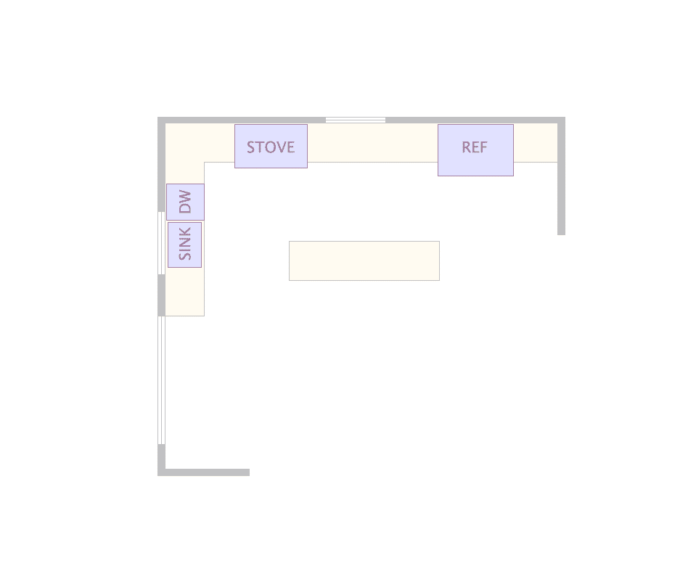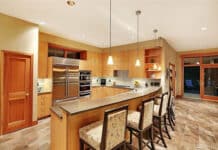One of the most important steps in remodeling a kitchen is taking measurements. Understanding the basic layout is crucial for ensuring cabinets fit perfectly in your kitchen remodel, as it involves planning the overall structure and design, including the kitchen’s shape, dimensions, and locations of key features.
Since the cabinets are a central kitchen feature, getting complete and accurate measurements is important. The proper measurements will make the ordering and installation of your ready-to-assemble (RTA) cabinets easy, allowing you to design your dream kitchen.
When buying RTA kitchen cabinets, a homeowner can view pictures online and order samples for assistance in choosing. However, taking proper measurements is the only way to ensure the cabinets fit in the kitchen space.
Knowing the exact measurements of the kitchen, including the full wall lengths, also makes it easier to figure out a budget for the renovation.
Prepare to Measure Your Kitchen for New Cabinets
To accurately measure kitchen cabinets, you will require a tape measure, pencil, notepad, or paper for recording measurements, and possibly a step ladder to reach higher cabinets.
These tools are essential in ensuring precise measurements for designing the layout and ordering perfectly fitting cabinets for your kitchen.
Measuring the dimensions of a kitchen is not a complex task, but it should be done meticulously. To obtain measurements for new kitchen cabinets, you will need the following items:
Tape measure
Pencil
Planning grid or scratch paper
Calculator
Step stool or ladder
Level ruler (to indicate any additional work required)
Laser measuring tool (optional but can be used to double-check measurements)
A measuring tape is indispensable for achieving precise measurements, especially when measuring cabinet doors and the full length of walls, rounding to the nearest eighth of an inch for accuracy.
When taking measurements, homeowners must strive for utmost precision and verify the measurements twice to ensure accuracy. Even rounding off to the nearest fraction can result in costly mistakes. All measurements should be recorded in inches.
How to Measure: Step-by-Step Guide
This step-by-step guide will ensure that homeowners will have the correct measurements for their new kitchen cabinets, even if they have never measured for them before.
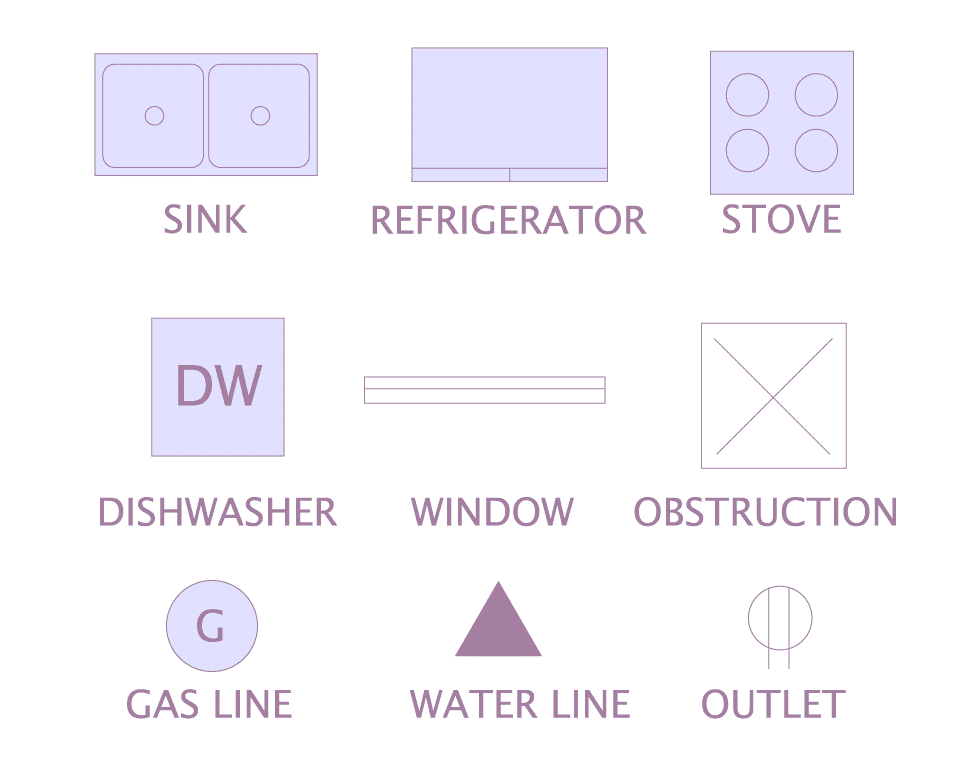
Step 1 – Make a Rough Sketch
The first step is to draw a rough plan of the existing kitchen or the new blueprint if anything will be changed. Grid paper can make drawing the layout easier.
Label all appliances, windows, and doors. Electrical, plumbing, and vents should also be marked. A key like the one below can be used to mark all of the items in the kitchen.
The layout drawing does not need to be perfect, but it should be clear and easy to understand.
Step 2 – Take Horizontal Measurements
Measurements should be taken from wall edge to wall edge in order to get the total space. The measurements for openings like doors or windows are taken from one underside of the trim to the other underside of the trim. The trim or molding around it is not included in the measurement.
Tip: All of the numbers should be written clearly so they are legible later and rounded to the nearest one-sixteenth of an inch.
Step 3 – Take Vertical Measurements
The distance from floor to ceiling at each corner and the middle of each wall should be noted on the rough sketch. The house might have settled, so it is important to measure several parts of the wall. The ceiling height indicated the ideal height of the upper cabinets.
Measurements should consider soffits. The soffit part is the wall that is hanging, down from the ceiling in front of certain areas like doors. If the kitchen has soffits, measure from the floor to the bottom of the soffit.
Ceiling heights are normally 8 feet in older homes and 9 feet in newer homes. Some homes might have even higher ceilings of 10 to 12 feet.
Step 4 – Find the Center Point of Existing Fixtures
Unless the kitchen layout changes, existing kitchen features such as appliances, sinks, and windows must be considered. The homeowner should measure the center point of all features.
To find the center point of the sink or stove, start at the end closest to the wall and measure toward it. The measurements stop at the middle part of the sink or the center of the stove.
If the sink or stove is located on an island, measure at the end of the island. For water and gas lines, measure from the wall to the center of the pipe or center of the appliance if it is still there.
Remember to consider the placement of electrical outlets when planning base cabinet dimensions, as they are crucial for kitchen functionality and safety.
Step 5 – Measure Doors and Windows
The same process should be completed for the windows and doors. The height and width should be recorded as well. It’s important to account for door openings when measuring for cabinet overlay to ensure a precise fit.
If the sink is centered on a window, this ensures the correct placement of the cabinets that are closest to the window. The standard size for doors is 80”x30”, but the width can be as wide as 36 inches or as narrow as 28 inches.
Windows come in various sizes, especially depending on the age of the home, so it is best to measure kitchen windows twice. Door and window frames and trim should be excluded from measurements.
Step 6 – Measure the Distance Between Objects to the Floor and Ceiling
The customer should next find the distance between objects on the wall and the floor and ceiling. This ensures that there are no obstacles in the way of the cabinets.
If an object is located over an installation spot, such as a window, the cabinets might need to be moved to accommodate it. If the flooring has been removed, it will change the vertical measurement but will not change the ceiling height.
Items such as ventilation, soffits, outlets, protruding walls, walkway dimensions for island installations should all be included in the floor plan.
Step 7 – Measure Existing Cabinets
The existing cabinets, including the wall cabinets, should also be measured to see what will fit. The homeowner should measure the height, width, and depth to understand the current cabinets and whether that size will work for the kitchen renovation.
Wall cabinets are crucial in determining dimensions based on the kitchen layout. Depending on the cabinet’s design, it might have additional features such as a toe kick, an oversized countertop, or a frameless door.
This will give an idea of the measurements needed for the new cabinets when only those are being replaced.
What Happens When the Measurements Are Incorrect
Accurate measurement of kitchen cabinets is essential, as any inaccuracies can lead to various mishaps during the renovation.
A wrong measurement can prove to be costly and disrupt the entire design. In case of an error, it may be necessary to return the cabinets, which is a complex process due to their size. This mistake can result in additional expenses for shipping and restocking fees that the homeowner will have to bear.
Furthermore, if the old cabinets have already been removed, the homeowner may be left without a functional kitchen for a period of time.
In addition, the homeowner will not know that an error has occurred until the cabinets and other major accessories are installed.
Depending on how the dimensions were measured, there can be a host of issues with installation, including obstructions such as pipes, outlets, or vents that may affect the installation of the cabinets.
For example, the cabinets might not reach all the way to the wall, or a drawer might not be able to fully open.
The cabinets might not be level, and the entire process must be repeated. Double-checking measurements and considering the dimensions of other accessories will help prevent this.
Standard Measurements for Wall Cabinets
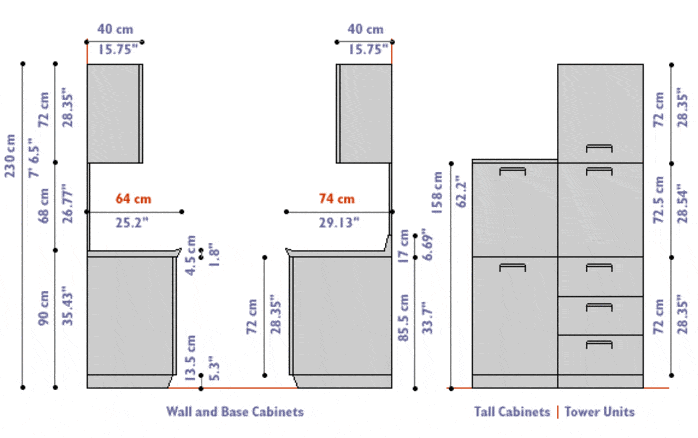
Ready-to-assemble cabinets come in standard sizes:
The base, or lower, cabinets are 24” deep from the wall and 34 ½” high. At the bottom, they have a 3” inset for the toe kick.
Upper cabinets are 12” deep and are available in 30”, 36”, or 42” heights. These choices accommodate different ceiling heights and whether the customer wants space above them.
Pantry cabinets, or tall cabinets, are 84”, 90”, or 96” high and 24” deep.
The width of cabinets varies, so getting the most accurate measurements lets the customer know what combination of cabinets will work in their kitchen space.
When considering replacing or installing new cabinet doors, it’s crucial to measure accurately, considering the specific types of overlays like full overlay or inset, as these will significantly impact the overall cabinet design.
How To Know What Will Fit
The standard height of lower cabinets is 34 ½ inches, and the standard thickness of countertops is 1 ½ inches.
The standard backsplash height is 18 inches. When these measurements are added together and then subtracted from the ceiling height, the maximum upper cabinet height that will fit in the remaining space is given.
Upper cabinets are usually 30, 36, or 39 inches high, so the homeowner must decide whether or not the upper cabinets should be taken up to the ceiling.
Some homeowners do not prefer tall upper cabinets because they are hard to access, while others like the look of cabinets that reach the ceiling.
Choosing the Right Cabinets for Your Kitchen Remodel
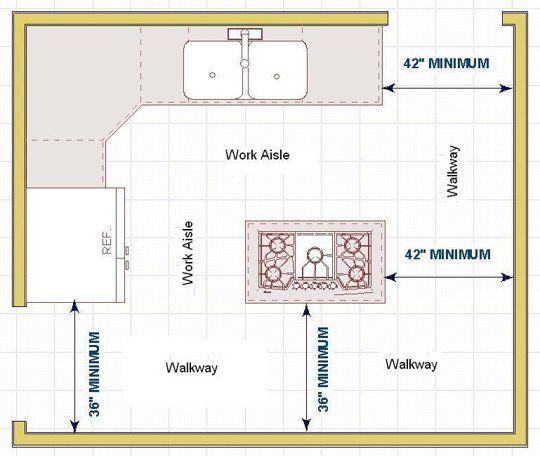
Once all the kitchen measurements have been meticulously recorded, emphasizing the importance of a detailed diagram of each wall from floor to ceiling, the homeowner can narrow down their cabinet choices.
The size of the cabinets will depend on the kitchen layout, which can be galley, u-shaped, i-shaped, or g-shaped or feature an island or double island.
It’s crucial to accurately sketch and label the kitchen measurements for the elevation plan, including the outside edge of the kitchen cabinets, to ensure a perfect fit and to facilitate planning the layout.
The layout design will determine the configuration of the cabinets. If the homeowner intends to change the space completely, a complete re-design of the kitchen cabinets must be undertaken, considering the available space and calculating the overlay for cabinet doors by drawing the outside edge on graph paper for kitchen plans.
The kitchen’s design and shape will also impact how the cabinets are configured. Most homeowners prefer a logical and functional work triangle consisting of a sink, refrigerator, and stove. The placement of cabinets should facilitate smooth functioning in the kitchen.
If the homeowner plans to relocate appliances, walls, windows, or doors, this will affect both the number and placement of cabinets. Any changes to the kitchen’s design or layout should be communicated to the designer so that appropriate adjustments can be made.
Additionally, after these changes are implemented, the kitchen must be remeasured while considering electrical outlet locations.
RTA cabinets are available in various options to meet many kitchen layouts. Taking correct measurements, especially noting the outside edge, will ensure a perfect fit.
For homeowners who need additional help with their kitchen cabinets, our expert designers can help them create a kitchen that is both beautiful and functional.

